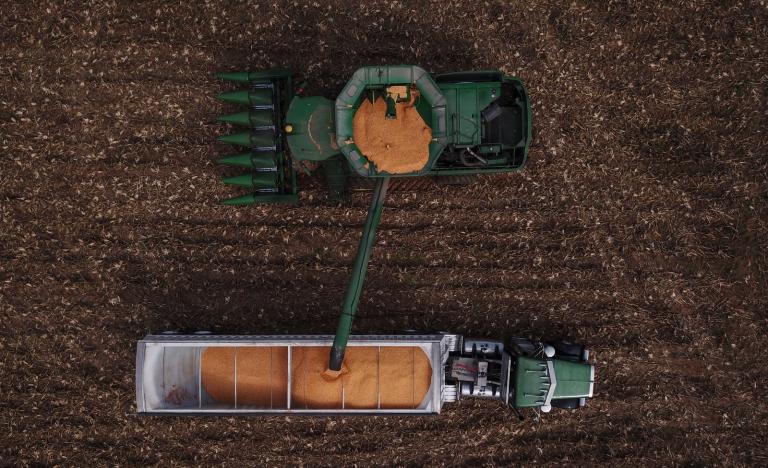Like a priceless painting, the beautiful blue and green swirl in a lake or pond presents a look-don’t-touch kind of situation. It’s the work of proliferating cyanobacteria, also known as blue-green algae, which produces toxins that are poisonous to humans and other animals, especially when blooms corrupt freshwater supplies. These toxins, which the microbes evolved to deter herbivores, are linked to ALS and Parkinson’s disease, plus muscle paralysis and liver and kidney failure. One of the toxins, anatoxin-a, is known as Very Fast Death Factor, in case you were doubting that toxicity.
It seemed a shame, then, that a highly nutritious fern called Azolla — that green mat ducks eat on ponds — long ago made a pact with a species of cyanobacteria, an “endocyanobiont.” Living inside the fern, the microbes get shelter, and provide the plant with essential nitrogen in return. Lately, scientists have been campaigning to turn the fast-growing Azolla into a food of the future. Others envision it becoming both a sustainable biofuel and a fertilizer that captures carbon. But these ideas aren’t likely to get very far if the cyanobacteria living within end up being highly toxic.
A new paper suggests that Azolla may find its way to plates one day: An international team of researchers discovered that endocyanobiont is no typical cyanobacteria. “The cyanobacteria that lives in Azolla doesn’t produce any of these toxins, and it doesn’t even have the genes required to create those toxins,” said Daniel Winstead, a Penn State research technologist and coauthor of the paper. “So that takes one of those barriers away towards its use as food or even livestock feed.”
This is not to say that anyone should find a local pond, skim off the Azolla, and eat it by the handful. Other research groups need to confirm that Azolla is fully nontoxic and safe for consumption before an industry can develop and produce the plant for food. Winstead’s previous research found that while some species of Azolla are high in harmful polyphenols, a species native to the southeastern United States called Carolina Azolla has much lower levels that are further lowered to safe amounts by cooking. Azolla is also high in protein and nutrients like potassium, zinc, iron, and calcium.
Azolla and the cyanobacteria it harbors have co-evolved a mutually beneficial relationship. Floating out in the open, other cyanobacteria species synthesize toxins to ward off hungry fish. “For the cyanobacteria to live within the Azolla, it can’t produce those toxins or it’d also kill the plant,” Winstead said. “So at some point, it didn’t have those genes anymore, and that’s unique among cyanobacteria.”
In return for providing the microbes housing, the Azolla gets an extremely valuable resource: nitrogen. Plants need that element to thrive, but not many species can pull it from the atmosphere themselves. So-called “nitrogen-fixers,” such as beans and clovers, rely on bacteria in their roots to process nitrogen into something the plant can use to grow. The endocyanobiont does the same for Azolla, helping supercharge the growth that allows the plant to double its biomass as quickly as every two days.
Winstead said that some smallholder farmers already use Azolla as fertilizer, and now that the cyanobacteria are confirmed to be nontoxic, perhaps the technique can spread. With that natural source of nitrogen, farmers would be less reliant on synthetic fertilizers, whose production and use spews greenhouse gases and pollutes rivers and lakes. Azolla could also be used as livestock feed, as some farmers are already doing if they can’t afford traditional feed for cattle and poultry.
Back in the 1980s and ‘90s, farmers in China managed to exploit Azolla for both purposes. They grew Azolla in their flooded rice paddies, added fish that fed on the plants, then ate the fish. But it was a difficult process. It was labor-intensive to grow, since farmers needed to separate the fishes before applying herbicides or pesticides. When the fields drained, crews worked the Azolla into the soils as a fertilizer, but that was labor-intensive, too.
While Azolla can fix its own nitrogen thanks to its cyanobacteria, it needed applications of phosphorus to really get growing in rice paddies. “There is no free lunch,” said Jagdish Ladha, a soil scientist and agronomist at the University of California, Davis, who wasn’t involved in the new paper. Those farmers in China switched to using cheap synthetic fertilizers instead. But the idea behind industrializing the production of Azolla would be to produce the plant at a larger scale, then conveniently package it as fertilizer or livestock feed.
Beyond its potential in farming, Azolla could also become a biofuel, according to Winstead, much as corn has been used to make biodiesel. That fuel would be close to carbon-neutral: As the plant grows, it sequesters carbon; burning the biofuel would then release that carbon back into the atmosphere. By incorporating Azolla into soils as fertilizer, farmers would put still more carbon into the ground.
Humans might also shape Azolla like they’ve modified other crops like wheat and corn, selectively breeding the most desired traits, such as bigger grains. “There’s a lot of potential for Azolla to go through that process,” Winstead said, “whether it’s creating a variation of Azolla that tastes the best, or it’s a variation of Azolla that has the most vitamins or the most protein, or maybe the best nitrogen-fixing ability.”



